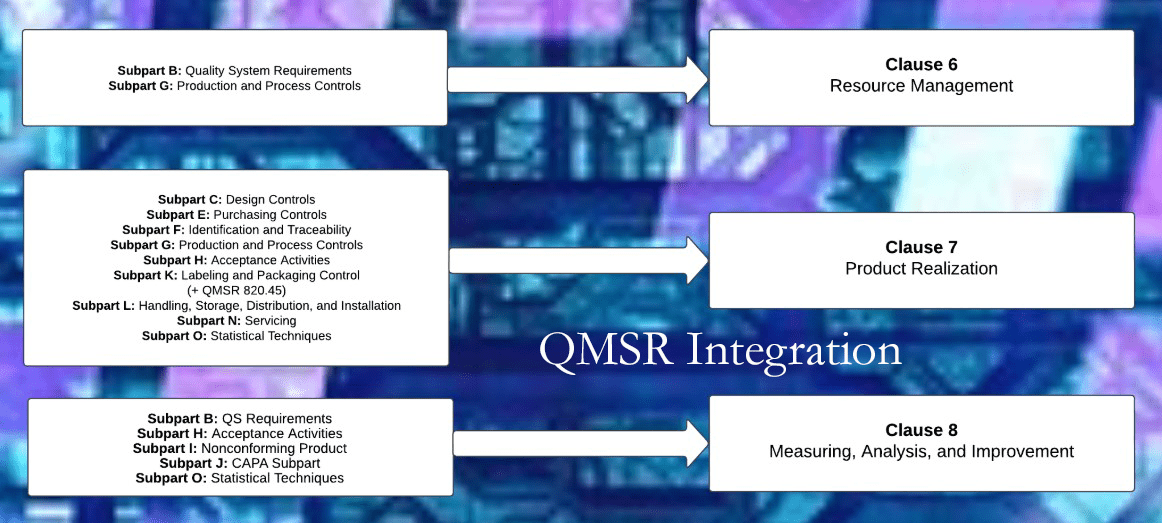QMSR Implementation
The U.S. Food and Drug Administration (FDA) has introduced significant updates to its regulatory framework for medical device manufacturers with the transition from the Quality System Regulation (QSR) to the Quality Management System Regulation (QMSR).
This modernization aligns with global standards, streamlining compliance for manufacturers who market devices internationally while maintaining a strong focus on patient safety and product quality.
Here’s a high-level overview of the key changes:
1. Alignment with ISO 13485
One of the most impactful updates is the alignment of QMSR with ISO 13485:2016, an internationally recognized standard for quality management systems in medical device manufacturing. This alignment reduces redundancies for manufacturers that already adhere to ISO 13485, simplifying the regulatory landscape.
While the framework and language now closely mirror ISO 13485, the FDA retains certain requirements to address unique U.S. regulatory needs, such as compliance with the Federal Food, Drug, and Cosmetic Act.
2. Terminology Updates
The QMSR replaces current terminology with vocabulary from the QSMR, ISO 13485:2016, ISO 9000:2015 (clause 3) and the FD&C Act to preserve codified definitions where needed, while more closely realigning with global standards. Examples of changes to QSR terms include:
- Management with Executive Responsibility will be known as Top Management.
- Medical Device Record (MDR) will be known as the Medical Device File (MDF).
- Design History File (DHF) will be known as the Design and Development File (DDF).
- Device History Record (DHR) will transition to the Device Batch Record.
These changes aim to ensure consistency with ISO 13485 terminology, fostering clarity and uniformity across regulatory environments. See the QMSR Definitions and Vocabulary page for more information.
The ISO 13485 and ISO 9000 standards are available for purchase at the ISO Store (https://www.iso.org/store.html).
They are also available in read-only versions at:
- The ISO 13485 standard can be accessed in a read-only format at the American National Standards Institute (ANSI) Incorporated by Reference (IBR) Portal.
- The ISO 9000 standard can be accessed at the ISO Online Browsing Platform (OBP).
3. Risk-Based Approach
A cornerstone of the QMSR is its emphasis on a risk-based approach to quality management. While risk management was implicit in the QSR, the QMSR explicitly integrates risk into all aspects of the quality management system. This approach encourages manufacturers to identify and mitigate risks throughout the product lifecycle, from design and development to production and post-market surveillance.
4. Supplier and Purchasing Controls
Purchasing controls under the QMSR place greater emphasis on supplier evaluation and monitoring. This change aligns with ISO 13485 requirements, focusing on ensuring that purchased products and services meet specified requirements through documented agreements and performance assessments.
5. Harmonization of Documentation Requirements
The QMSR harmonizes documentation requirements with ISO 13485, streamlining processes for manufacturers operating globally. This includes clearer expectations for:
- Establishing and maintaining a quality manual.
- Defining processes for document and record control.
- Creating comprehensive procedures for product realization.
6. Focus on Continuous Improvement
The QMSR reinforces the importance of continuous improvement in quality management. Manufacturers are encouraged to use tools like internal audits, corrective and preventive actions (CAPA), and management reviews to consistently evaluate and enhance their systems.
Preparing for the Transition
The QMSR officially takes effect on February 2, 2026, but manufacturers should begin their transition planning now to ensure compliance. Steps include:
- Conduct a gap analysis to compare existing quality systems under QSR with QMSR requirements.
- Update documentation, procedures, and records to align with QMSR and ISO 13485 standards.
- Note: Your organization is required to maintain compliance with the current 21 CFR Quality System Regulation through February 1, 2026 – so ensure that any documentation updates made prior to then are not in conflict with or otherwise non-compliant to the QSR.
- Train and certify employees on the new requirements and their implications for daily operations.
- Engage with regulatory consultants or third-party auditors to ensure a smooth transition.
Conclusion
The shift from QSR to QMSR marks a significant step forward for U.S. medical device regulation, fostering global alignment and a more comprehensive approach to quality management.
While the transition requires effort, the long-term benefits—simplified compliance, reduced duplication, and improved product quality—make it a worthwhile investment for manufacturers.
The transition will involve blending a significant number of information pieces from different sources, which can be complicated.
Stay ahead by starting your transition plan today. If you need guidance, consulting services, or resources, reach out to our team at Medical Devices and Pharma for expert and easy-to-understand support.
How We Can Help
QMSR Central is your destination for:
- Educational Resources
- Blogs and articles explaining key QMSR concepts
- Online or on-site training
- Step-by-step guides to implementing QMSR requirements
- FAQs to answer your most pressing questions
- Consulting Services
- Quality system audits
- Documentation review and updates (Quality Manuals, SOPs, etc.)
- Gap analyses to identify compliance needs
- QMSR establishment and compliance guidance
- Compliance Tools
- Checklists for QMSR implementation
- Templates for documentation
- Updates on regulatory changes

